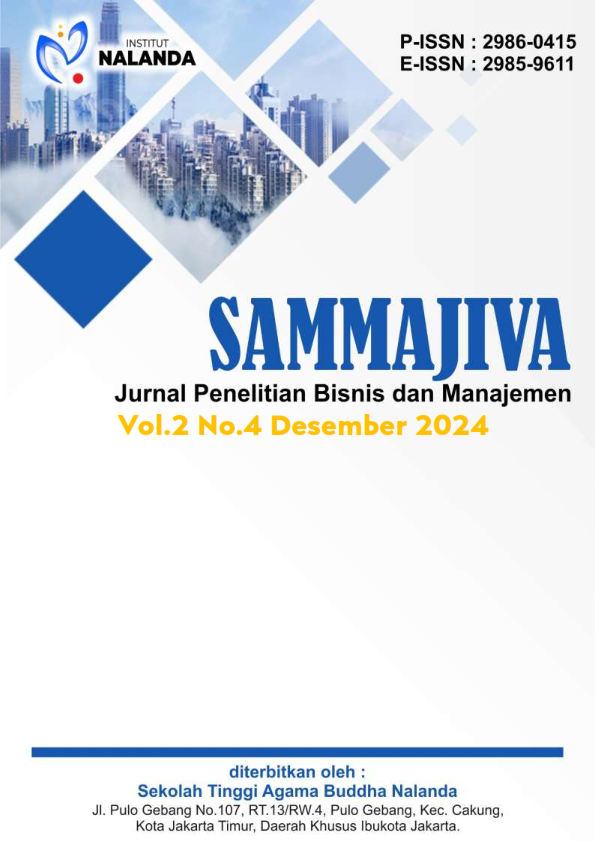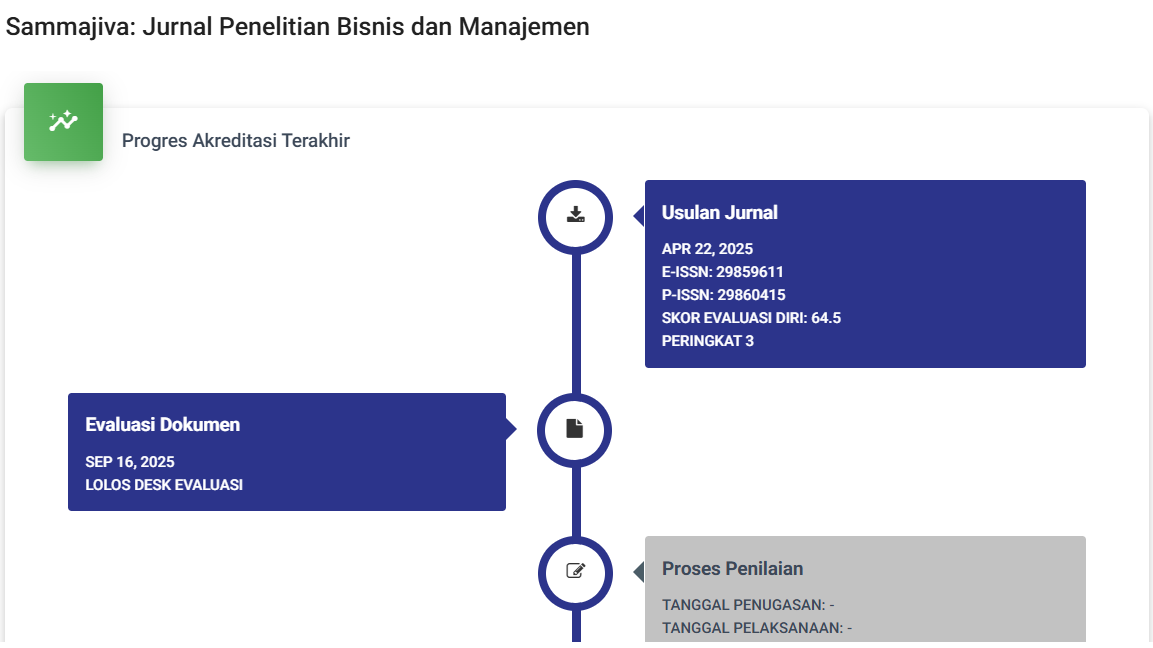Komunikasi Word of Mouth
(Studi Kasus Strategi Penjualan of Mouth Offline dan Online pada Generasi Milenial di Ibat Daun Palembang)
DOI:
https://doi.org/10.47861/sammajiva.v2i4.1588Keywords:
Communication, Word of mouth, on-line, off-lineAbstract
This study aims to determine the marketing strategy of Rumah Makan Ibat Daun Palembang, as well as the obstacles in carrying out promotions using word of mouth on-line and off-line. The paradigm of this research in constructivism is the result of socio-cultural construction in communication activities using word of mouth. This type of qualitative research with a case study approach. Data collection techniques using interviews and non-participant observation, the researcher acts as an observer. The research findings prove that the Ibat Daun Restaurant uses online word of mouth communication in marketing its restaurant products through instagram, facebook, blogger, websites and the Sriwijaya Post newspaper. The communication used uses five dimensions, namely word of mouth, namely Talkers: consumers, management, family , and best friend; Topics: about RM. Ibat Leaf; Tools: verbal communication; Talking Part: individuals and communities; and Tracking: giving questionnaires to and interviewing consumers. Based on the findings, it proves that the reason Ibat Daun Restaurant uses word of mouth communication is because word of mouth communication does not require a large amount of money, while the obstacles experienced are hoaxes circulating on-line or off-line which can give the restaurant a bad reputation. Ibat Leaf. The solution adopted is to provide an attractive lay-out on social media and provide the best service, using the services of influencers
References
Aghnia Dian Lestari. (2016). Implementasi word of mouth communication objek wisata Ciletuh. Jurnal Scientica, 3(1). https://ejournal.unisba.ac.id
Andrian, N. (2016). Pengaruh periklanan terhadap keputusan pembelian konsumen pasta gigi Pepsoden di Makassar, Sulawesi Selatan. Jurnal Economix, 4(2), 1-10.
Burhan, B. (2009). Sosiologi komunikasi. Jakarta: Kencana.
Citra Aprilliani Putri, Handoyo Djoko W., & Sari, L. (2016). Pengaruh kualitas pelayanan, kualitas produk, dan word of mouth communication terhadap keputusan pembelian pada RM Garang Asem Sari Rasa (Studi pada konsumen RM Garang Asem Sari Rasa, Kudus).
Dimyati, N. S. (2009). Komunitas kafe sebagai gaya hidup (Studi tentang motif mahasiswa dan konstruksi kuliner kafe di Yogyakarta) [Unpublished bachelor's thesis]. Fakultas Ushuluddin UIN Sunan Kalijaga, Yogyakarta.
Euromonitor. (2010). Analysis report: The Foodservice Indonesia industry. https://www.google.com
GoFood. (2018). Empat tantangan bisnis kuliner dan cara mengatasinya. https://www.gojek.com
Herlyana, E. (2012). Fenomena coffee shop sebagai gejala gaya hidup baru kaum muda. Jurnal Thaqafiyyat, 13(1), 1-10.
Juang, N. (2016). Analisis kepuasan pelanggan pada restoran Sop Tunjang Pertama (MI) di Pekanbaru. Jurnal Valuta, 2(2), 21-30.
Kiki Joesyiana. (2018). Pengaruh word of mouth terhadap keputusan pembelian konsumen pada media online shop Shopee di Pekanbaru. Jurnal Valuta, 4(1), 45-55. https://journal.uir.ac.id
Kotler, P., & Armstrong, G. (2009). Prinsip-prinsip pemasaran. Jakarta: Erlangga.
Kotler, P., & Armstrong, G. (2010). Principles of marketing. New Jersey: Pearson.
Kotler, P., & Armstrong, G. (2018). Prinsip-prinsip marketing (Edisi ke-7). Jakarta: Salemba Empat.
Muhammad David Hendra, M. A., & Hadi, M. (2021). Efektivitas word of mouth (WOM) dalam komunikasi pemasaran Rotte Bakery Pekanbaru. Jurnal Medium, 9(2), 50-61. https://doi.org/10.25299/medium.2021.vol9(2).7907
Nielsen, A. C. (2007). Survei of consumer behavior and perception toward modern retail and traditional trade channels. Jakarta: Departemen Perdagangan Indonesia.
Ningtyas, S. A. (2018). Pengaruh komunikasi dari mulut ke mulut (word of mouth). uns.ac.id. https://jurnal.fkip.uns.ac.id
Oey, M. (2022). Business feasibility study: Joyinz Café at KH. Soleh Ali, Tangerang. International Journal of Management and Sciences (IJOMAS). https://doi.org/10.5555/ijosmas.v3i2.144
Peraturan Menteri Kesehatan No. 304 Tahun 1989 Tentang: Persyaratan Kesehatan Rumah Makan dan Restoran. https://dinkes.bandung.go.id
Rahardi, D. R. (2007). Perilaku pengguna dan informasi hoax di media sosial. Jurnal Manajemen dan Kewirausahaan. https://doi.org/10.26905/jmdk.v5i1.1342
Sernovitz, A. (2009). Word of mouth marketing. Jakarta: Gramedia Pustaka Utama.
Strauss, W., & Howe, N. (2022). Millennials rising: The next great generation. Knopf Doubleday Publishing Group. ISBN: 0307557944, 9780307557940.
Suhendra. (2015). Efektivitas word of mouth terhadap minat beli konsumen. Jurnal Visi Komunikasi, 14(1), 117-131.
Sumiyati, A. R. (2022). Analisis persaingan bisnis pada usaha kuliner dalam meningkatkan pelanggan menurut perspektif etika bisnis Islam. Jurnal Kaffa, 1(2), 1-23.
Sutisna. (2012). Perilaku konsumen dan komunikasi pemasaran. Bandung: PT. Remaja Rosdakarya.
Teja, S. I. W. K. (2016). Restaurant revenue management. Jurnal Undhira, 11(2), 1-10. https://jurnal.undhirabali.ac.id
Vibiznews. (2007). Sales & marketing, buzz marketing, paling efektif di Indonesia. Journal of Emotional Benefit. https://phpvbis-emotionalbenefit.htm
Walker, H. L., & Jean, S. (2003). The measurement of word of mouth communication and an investigation of service quality and customer commitment as potential antecedents. Journal of Service Research, 4(1), 60-75.
West, R., & Turner, L. H. (2008). Pengantar teori komunikasi, analisis dan aplikasi. Jakarta: Salemba Humanik.








